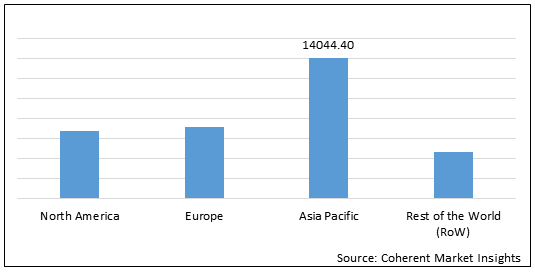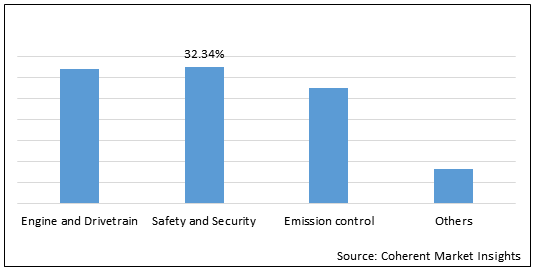Car sensors are intelligent systems that control different aspects such as coolant levels, temperature, emission levels, oil pressure, and many more. These sensors work constantly right from the time car is powered up until it is turned off. The various sensor types are temperature sensors, exhaust gas, knock, air mass flow, and crankshaft position which subsequently are used to enhance powertrain performance (which comprises over 50% of the total applications of automotive sensors). These sensors seek their application in various classes utilized in motor vehicles such as physical property, process variable, proximity and positioning, chemical property, and others such as imaging sensors.
The U.S. motor vehicle sensor market is estimated to be valued at US$ 36,952.2 million in 2021 and is expected to exhibit a CAGR of 11.9% % over the forecast period (2021-2028).
Recent Developments:
Asia Pacific held dominant position in the U.S. motor vehicle sensor market in 2020, accounting for 43.10% share in terms of volume, followed by Europe and North America, respectively. Increase in adoption of autonomous braking systems, lane-keeping assist, and adaptive cruise control systems dominates the Asia pacific market.
Figure 1. U.S. Motor Vehicle Sensor Market Value (US$ 14,044.4 Mn), by Region, 2020

To learn more about this report, Download Free Sample
U.S. Motor Vehicle Sensor Market: Drivers
Stringent regulatory compliance is expected to drive growth of the U.S. motor vehicle sensor market during the forecast period
Various laws and regulations at state, federal, and local levels have significant control over the demand for motor vehicle sensors. The emergence of various government regulations mandates the use of vehicle sensors. For instance, the TREAD Act of 2000 mandates the requirement of tire pressure monitoring systems (TPMS) for all model year 2007 light vehicles for monitoring the air pressure in the vehicle tire and alerting the driver when the pressure in the tire is low. The government mandates have helped support demand proximity and positioning sensors in applications such as occupant position sensors used with advanced airbag systems. These systems, which have been mandatory in all new vehicles, utilize a range of sensors to detect the weight and size of an occupant and its proximity to the airbag module in order to ensure safe deployment of the airbag in the event of an accident. Therefore, these factors are expected to drive growth of the U.S. motor vehicle sensor market during the forecast period.
Advancements in technology are expected to propel the U.S. motor vehicle sensor market growth over the forecast period
The development of new applications for technologies such as micro-electromechanical systems (MEMS) optoelectronics and photoelectronic has increased the sales of sensors. Technological developments in materials and electronics have led to the miniaturization and integration of sensors into intelligent devices and systems measure and analyze as well as act on the resultant information. The manufacture and embedding of smaller sensors into products is becoming a high-growth industry. Sensors have become an integral component of all automotive electronic systems and developments in sensor technology allow for improvements in the automotive electronics subsystems and modules that contain them. Thus, these factors are expected to propel the U.S. motor vehicle sensor market growth in the near future.
U.S. Motor Vehicle Sensor Market Report Coverage
| Report Coverage | Details | ||
|---|---|---|---|
| Base Year: | 2019 | Market Size in 2021: | US$ 36,952.2 Mn |
| Historical Data for: | 2016 to 2019 | Forecast Period: | 2021 to 2028 |
| Forecast Period 2021 to 2028 CAGR: | 11.9% | 2028 Value Projection: | US$ 60,939.7 Mn |
| Geographies covered: |
|
||
| Segments covered: |
|
||
| Companies covered: |
Robert Bosch GmbH, Hitachi Ltd, Denso Corporation, Eaton Corporation, Delphi Automotive, Continental AG, and Valeo SA |
||
| Growth Drivers: |
|
||
| Restraints & Challenges: |
|
||
Uncover macros and micros vetted on 75+ parameters: Get instant access to report
U.S. Motor Vehicle Sensor Market: Opportunities
Massive demand from the Chinese market can present major growth opportunities in the U.S. motor vehicle sensor market
China is the world’s largest market for motor vehicles and also the biggest manufacturer of motor vehicle products and equipment. The sensor demand across all major motor vehicle systems is closely tied to the developments in-vehicle use and production. The production of motor vehicles in China is continuously rising and this in turn is creating potential opportunities for the sensor market. As the automobile market matures, Chinese consumers are becoming more concerned about fitting more technologically advanced sensors in their vehicles. Many have already purchased an entry-level vehicle and are ready to upgrade to newer and better models.
Advent of sensor fusion can provide key business opportunities in the U.S. motor vehicle sensor market
Sensor fusion refers to the ability to bring together inputs radars, cameras, and LIDARs to form a single model or image of the environment around a vehicle. It is basically combining sensory data derived from disparate sources such that resulting information has less uncertainty. The resulting model is the most accurate since it balances the strengths of different sensors. Many automotive manufacturers increasingly adopt sensor fusion, in order to improve the quality of vehicles and expand the market presence.
Market Trends:
Mergers and acquisitions among market players
Major companies operating in the market are focused on mergers and acquisitions, in order to enhance the market presence. For instance, in September 2012, Robert Bosch GmbH acquired SPX Service Solutions with an aim to become a comprehensive supplier of diagnostics and repair solutions in the automotive domain. In June 2011, Valeo acquired Niles, a Japan-based automotive part manufacturer.
Contracts and agreements among market players
Key players in the market are forced on contracts and agreements, in order to gain a competitive edge in the market. For instance, in March 2012, Delphi Automotive entered into a distributor agreement with TTI Asia, thus expanding its distribution network and escalating its global presence.
Figure 2. U.S. Motor Vehicle Sensor Market Share, By 32.34%, 2020

To learn more about this report, Download Free Sample
Key Takeaways of the Graph:
U.S. Motor Vehicle Sensor Market: Restraints
High cost of implementation is expected to hamper the U.S. motor vehicle sensor market growth over the forecast period
The demand for automotive sensors is highly cost-sensitive and the newly introduced vehicle sensors are highly expensive and hence they are used in premium vehicles only. This cost sensitivity of sensors remains a major market. Some of the above-mentioned sensors have been made mandatory by the government and are thus necessary in all automobiles, for example, pressure sensors which have a high cost of implementation has been mandated by the U.S. government and has to be fitted in all vehicles within the country. Therefore, these factors are expected to hamper the U.S. motor vehicle sensor market growth over the forecast period.
Low preference for diesel cars is expected to restrain growth the U.S. motors vehicle sensor market during the forecast period
Majority of consumers are inclined towards petrol cars over diesel cars. This is owing to high fuel efficiency, low maintenance, and low emission. As a result of this, the demand for motor vehicle sensors is significantly hindered. Thus, these factors are expected to restrain growth of the U.S. motors vehicle sensor market over the forecast period.
U.S. Motor Vehicle Sensor Market: Competitive Landscape
Major companies operating in the U.S. motor vehicle sensor market are Robert Bosch GmbH, Hitachi Ltd, Denso Corporation, Eaton Corporation, Delphi Automotive, Continental AG, and Valeo SA.
Share
Share
Missing comfort of reading report in your local language? Find your preferred language :
Transform your Strategy with Exclusive Trending Reports :
Frequently Asked Questions
Select a License Type
Joining thousands of companies around the world committed to making the Excellent Business Solutions.
View All Our Clients